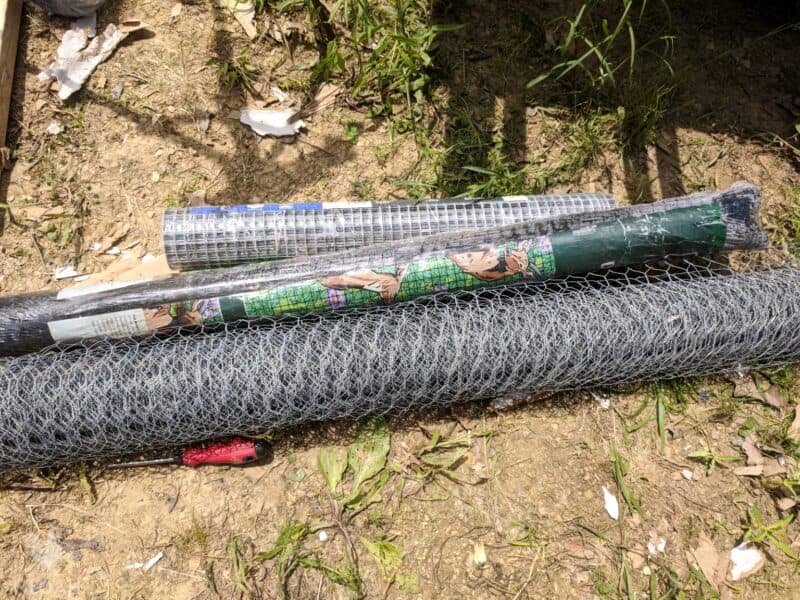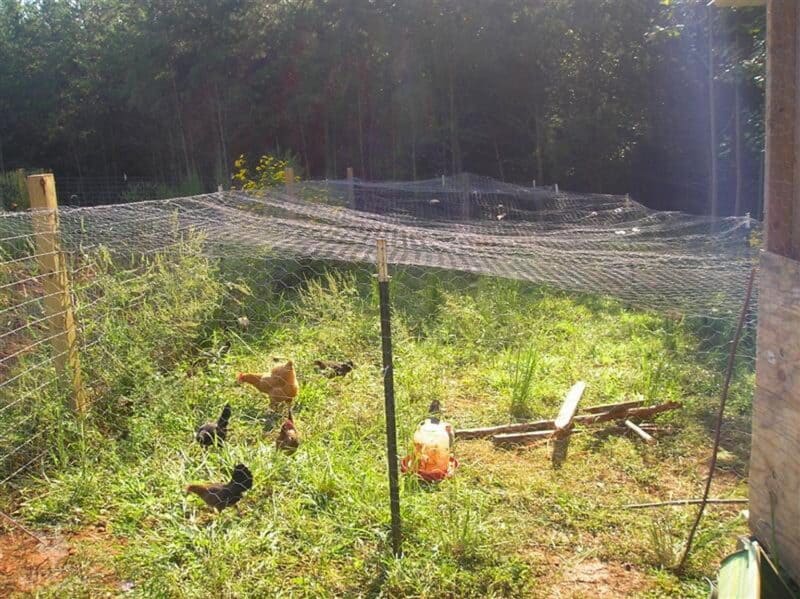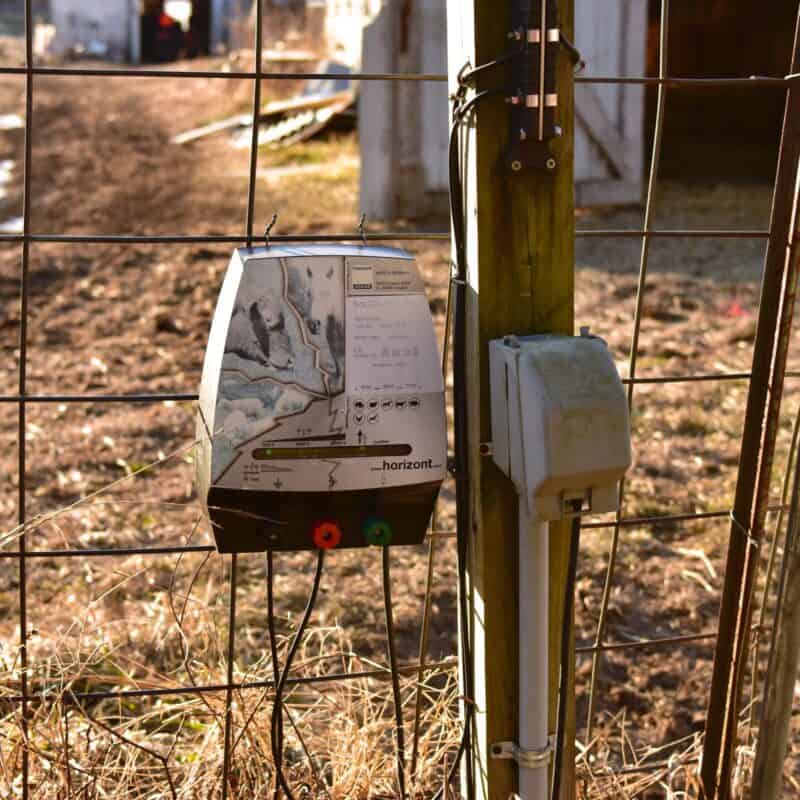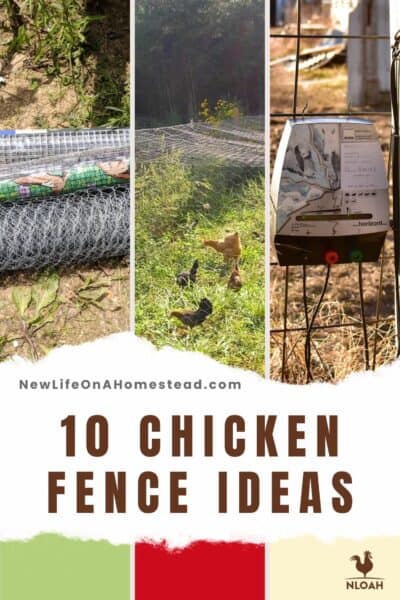Whether you want to let your chickens free-range or you prefer to keep them in a smaller, fenced run or other enclosure, you’ve got to have a good fence. “Good fences make for happy flocks,” that’s the old saying! Actually, I might have that wrong – but it’s still the truth!

The trick is picking the right kind of fencing for your property and for your own flock. There are tons of options out there on the market, whether you want to DIY your own or go with a purpose-made solution that’s easy to set up and tear down in no time.
Rifling through all the different options and comparing them can be tough, so to help you do that I’m bringing you a list of the 10 best ones to keep your chickens right where you want them.
What’s the Best Material for Chicken Fencing?
Before we go further, you might want to know the fundamental differences between the different types of fencing material, used to contain chickens.
Basically, these are metal, wood, and plastic.
Metal typically takes the form of some type of wire. It has the advantage of being very strong, and is the best option for keeping out predators, but it is typically the most expensive and the most prone to degradation from corrosion. Metal also poses significant risks for injury when it is broken or cut.
Wood is a great option, looks friendly and can last for a long time if chosen carefully and finished properly but it is vulnerable to rotting and fence variations that will contain chickens usually require plenty of additional fasteners and lots of work to erect.
Plastic fencing is cheap, light, easy to move and usually easy to set up with a minimum of fuss. The bad news is that it is barely strong enough to keep chickens in and will only keep certain kinds of predators, like birds of prey, out. For larger predators, the best it will usually do is buy you time. However, it remains a viable option for ad hoc or temporary containment.
Keep these material advantages and disadvantages in mind as you assess the following fencing options.

Chicken Wire
Disclosure: if you visit an external link in this post and make a purchase, I may earn a commission. Read my full earnings disclosure here.
You can’t go wrong with a classic. Chicken wire is known as chicken wire for a reason: it is nearly the perfect fencing option for containing chickens!
It’s reasonably strong, affordable, easy to handle, can keep any chicken inside, and keep most larger predators out as long as you take a little care when installing it.
Don’t make the mistake of putting it up with flimsy posts, and bury the wire at least 6 inches in the ground; then you will be in business.
The ubiquity of this stuff is one of its best advantages. You can get chicken wire literally anywhere, from hardware stores and home improvement centers to dedicated farm and livestock providers.
Plastic Safety Fencing
Plastic safety fencing is that bright orange or green plastic mesh that you see strung up around a construction site, up on a scaffold or any other place where you need a high visibility indicator and something that’s nominally capable from stopping movement.
It often has square or rounded rectangular openings, and is usually hung from metal posts or weighted plastic bollards that can be easily repositioned. Sometimes it’s used with wooden posts.
The advantages of this type of fencing are that it is very cheap and extremely easy to handle and hang. You won’t be getting jabbed with any metal wires, and it’s almost impossible that it will hurt your birds or other animals.
The downside is that it really won’t keep any predators out. It can be torn, chewed and easily dug under.
On the other hand, if something falls on it or if your chickens mess with it enough, it can start to stretch out, perhaps allowing escapes.
This isn’t the ideal option for safely containing chickens, but it works well for temporary paddocks, emergency fencing, or for owners that are on a strictly limited budget and don’t mind increased vulnerability to predators.
Aviary/Run Netting
Aviary or chicken run netting is somewhat similar to the safety fencing above, typically made of plastic but sometimes found as a fabric option. Unlike fencing, this netting is designed to be placed over your chickens to keep birds of prey out and flight-capable chickens in.
If you live anywhere with a significant bird of prey presence, this stuff is mandatory unless you’re willing to accept losses when letting your chickens out into the run or free range.
It’s affordable and easy to handle, and can integrate with virtually any other type of fencing, but the expense of covering a large area can increase quickly. Accordingly, it is typically limited to purpose-built bird enclosures or chicken runs rather than protecting open pasture.
In a pinch, you can use this like you would plastic safety fencing to set up a temporary enclosure in case a permanent one is damaged or if you just need to relocate your chickens for whatever reason.
It’s good to keep plenty of extra on hand, because it will get torn up from accidents and attacks.
Welded Wire
Welded wire fencing is another ubiquitous metal type used for containing all kinds of animals, not just chickens. Reasonably affordable and fairly strong, it is a good entry-level fencing.
As you might expect from the name, the intersections between the wires that form a grid pattern are spot-welded in place.
As always, using good posts and anchors is important for performance and safety, but I warn you that welded wire is still one of the weaker types of metal fencing even when installed correctly…
The individual welds are fairly weak and seem to corrode and snap quickly from even modest abuse or exposure to weather.
The larger gaps in this fencing will keep chickens in, but will still admit many kinds of chicken predators like snakes, rats, raccoons, and the like.
However, if carefully installed and buried with a border of gravel, it can prove to be effective against coyotes and other larger canines. Overall, not a bad option but one that is best employed with an understanding of its limitations.
½” Hardware Cloth (aka rabbit cage wire)
½” hardware cloth, more popularly known as rabbit cage wire is basically a supercharged type of welded wire fencing. In essence, it combines the advantages of welded wire fencing and chicken wire with few disadvantages except for cost.
It’s much stronger than welded wire and even stronger than chicken wire fencing because of its thicker diameter and more numerous, higher-quality welds.
The gaps between strands are only half an inch, meaning that at any given point of impact or attack there is considerably more strength holding the fence together.
All around, an excellent choice especially if you bury it properly to stop predators from digging under it.
¼” Hardware Cloth
Do you love hardware cloth but wish it were even stronger, even better? Do I have good news for you!
Hardware cloth is available in multiple sizes which denote the spacing between the strands. Even better than the ½” stuff typically used for rabbit cages, ¼” hardware cloth has even smaller openings and is correspondingly even tougher.
Better yet, this terrific fence can keep out all but the smallest critters with only bugs, mice and the smallest snakes being able to slip through. Goes without saying it can easily contain all adult chickens and chicks…
This stuff is so tough it can withstand a prolonged attack from a coyote, fox, or determined dog as long as they aren’t able to jump over or dig under it.
My personal favorite arrangement that gives me maximum peace of mind is to bury it with an equally deep layer of large gravel extending out about 6 inches to either side; this makes it brutally hard for these other animals to dig through without tearing up their paws.
You’ll pay for this level of protection, but if you live in a state with lots of vicious predators lurking around your homestead, I think it’s worth it…
Chain-link Fencing
Sometimes overlooked for enclosing chickens, if you want maximum longevity and a pretty decent appearance, chain link fencing can keep out the largest predators that roam on the ground – again, assuming they cannot jump over it or dig beneath it.
The biggest drawbacks with chain link fencing is that it is very expensive compared to our other metal fencing types and it can be challenging to install.
Also keep in mind that the larger gaps in chain link fencing will allow rats, mice, larger snakes and other similarly sized creatures to get in and out with no problems.
If you want to keep those critters out, you’ll need to go with hardware cloth or chicken wire. But if you want to enclose a larger parcel or pasture, keep appearances, and be able to depend on the strength of your metal fencing for longer, chain link is a fine option.
Wood Pickets
Wood picket fencing has been a standard around the world basically forever. It’s reliable, adaptable and if kept in good repair has an undeniable cottage- or farm charm that completely surpasses the other more utilitarian options on this list.
Assuming you make it tall enough, it is more than strong enough to contain chickens but it can break down with sustained assaults from larger predators.
Any weak spots, gaps, loose boards and so forth will be ruthlessly exploited until you shore them up, and wood fencing as always is highly vulnerable to degradation from weather and pests.
The good news is that if a single plank goes bad it can be replaced easily; you won’t have to replace an entire section as you would with metal fencing.
Cost, unfortunately, is definitely a factor depending on what kind of wood you want to use and how nice you want the fence to look, and that isn’t even accounting for the many fasteners you’ll need and finishing on top of that.
But assuming you’re handy with installation, it can still be reasonably affordable for the performance it provides.
Pallet Fencing
Part of being a homesteader is making do with less and improvising, and no kind of fencing takes that ethic to heart like pallet fencing.
You probably already know by now that pallets have 101 uses for construction, crafts and all sorts of other DIY activities including chicken coops. You can easily repurpose a pallet into fencing by stringing together using a few posts and nails or screws.
The advantage, of course, is that pallets are very, very cheap or even free depending on how you acquire them. They’re also surprisingly sturdy assuming they have any service life left.
The downside is that there are inevitably gaps that you’ll have to shore up using extra wood, and the aesthetic is definitely, how do you say, post-apocalyptic.
But if “needs must”, or you just care about saving the most money possible pallet fencing is totally viable for containing backyard birds that can’t fly or jump very high, and even if they can you can always just add more pallets!

Electric Fencing
Electric fencing might seem like overkill for chickens, but not when you think about the totality of the circumstances.
Yes, it’s expensive. Yes, it will give chickens a painful pop if they touch it. But electric fencing will also deter predators in no uncertain terms and keep chickens from straying.
That, combined with its relative ease of setup makes it highly attractive in many kinds of situations.
The major downside is, of course, the cost of the components and the requirement for electricity. Depending on how your homestead is set up this can be easier or cheaper to supply, though solar systems are making electric fencing at the small scale more viable than ever.
The other concern is, of course, for other animals on your farm and potentially children and pets, though they too will learn to stay away from the fence if they stray too close! If you’re handy with electricity and electronics, you can save a bundle on setup, too.
Before you leave, be sure to save all of these ideas for later in one of your Pinterest boards!

Tom has lived and worked on farms and homesteads from the Carolinas to Kentucky and beyond. He is passionate about helping people prepare for tough times by embracing lifestyles of self-sufficiency.
